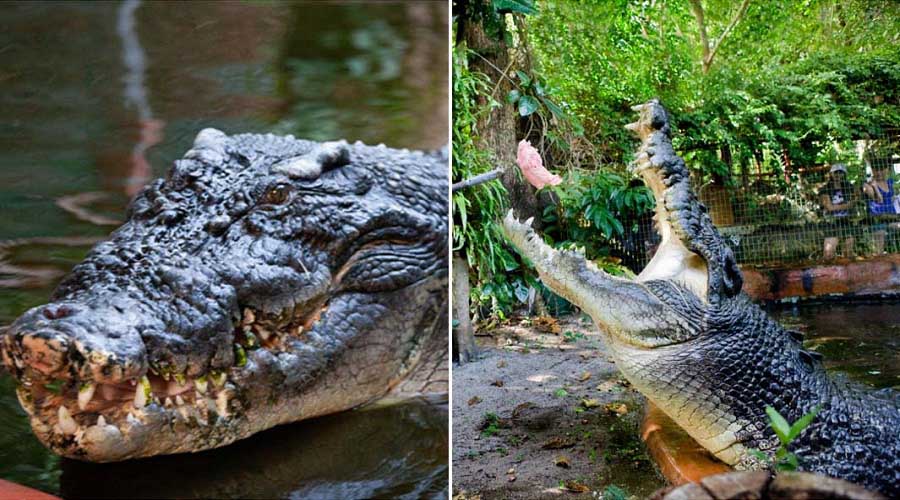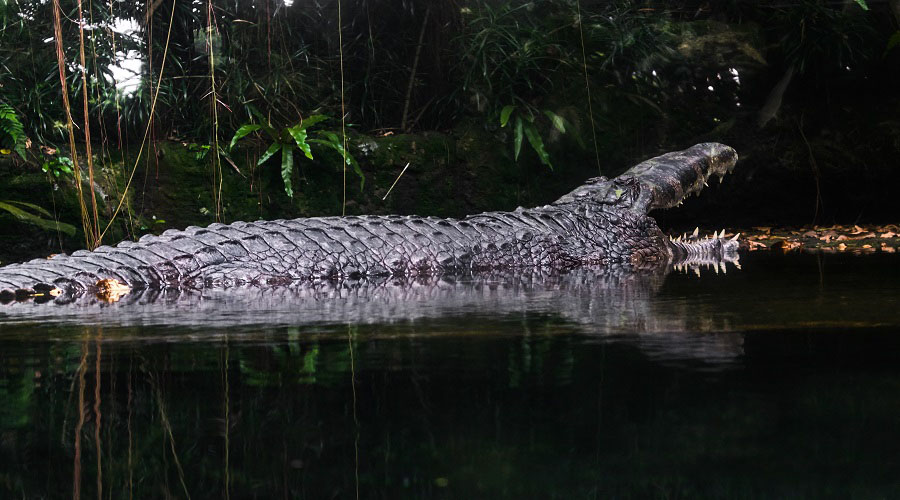Table of Contents
The saltwater crocodile, scientifically known as Crocodylus porosus, is a crocodilian species that primarily inhabits saltwater habitats, brackish wetlands and freshwater rivers ranging from India’s east coast across Southeast Asia and the Sundaic region up to northern Australia and Micronesia.
The species has been categorized as Least Concern on the IUCN Red List since 1996, although it was extensively hunted for its skin throughout its range until the 1970s. Currently, the saltwater crocodile remains threatened by illegal killing and habitat loss. Due to its aggressive nature towards humans, the species is highly regarded as dangerous.
The saltwater crocodile is the largest living reptile
The male estuarine crocodile, also known as the Indo-Pacific, marine, sea, or saltie crocodile, can attain a maximum length of 6 m (20 ft), with an occasional rare specimen reaching 6.3 m (21 ft), and weigh between 1,000–1,500 kg (2,200–3,300 lb). In comparison, females are significantly smaller, with a typical maximum length of only 3 m (10 ft).

biggest saltwater crocodile in australia
As a large hypercarnivorous apex predator, the crocodile is opportunistic in its feeding habits and predominantly employs an ambush strategy to catch and consume its prey. The crocodile’s diet comprises a wide range of animals including different types of fish and crustaceans, reptiles, birds, and mammals, including humans. Their diet is not restricted to prey within their habitat but also includes other predators such as sharks.
The crocodilian specimen of the greatest size in the world, purported to surpass the age of 110 years, is continuing to experience growth
The current holder of the Guinness World record for the largest captive crocodile is Cassius, an Australian saltwater crocodile. According to the animal’s caretakers, its size continues to increase. As reported on Foxnews.com, a professor measured Cassius at 17 feet and 11.75 inches during a recent visit, which is 13 inches more than recorded nearly two decades ago. The Guinness World record website also confirms Cassius’ length as 17 feet and 11.75 inches.

Cassius, an Australian saltwater crocodile, holds the Guinness World record for being the largest crocodile
According to the Guinness World website, it is reported that Australian saltwater crocodiles have the capacity to endure beyond 100 years and carry a weight of over a tonne. In 1987, Cassius, who was brought from Australia’s Northern Territory, was transported a distance of 3,200 km (1.988 miles) to Green Island by truck.
Cassius, who was captured in 1984 in the Finis River located in Northern Territory Australia, has been a resident of the Marineland Crocodile Park for more than 30 years. As stated on the official website of the Marineland Crocodile Park, Cassius is among the many crocodiles that call the park their home.

Cassius, an Australian saltwater crocodile
According to the Marineland Crocodile Park website, Cassius was the dominant figure in the area of the Finis River where he was captured. The other creatures residing in close proximity to him would have been aware of and intimidated by his presence, evidenced by the multiple battle scars and wounds he bears as a reminder of his earlier days in the wilderness. It is also noteworthy that he was notorious for attacking boats and consuming outboard motors, which may have resulted in the shortening of his snout caused by a spinning propeller.
The website of Marineland Crocodile Park states that its founder, George Craig, takes pleasure in feeding Cassius personally. The website quotes, “After almost three decades of taking care of this magnificent creature, George has established an extraordinary bond with Cassius that is truly remarkable to witness.” This emphasizes the unique connection between the caretaker and the crocodile that George has developed over the years.
Based on estimations, Cassius’ age falls within the range of 110 to 120 years. According to Oldest.org, the longest living captive crocodile to date was Freshie, who lived for a total of 140 years. Freshie was captured by Steve and Bob Irwin in 1970 from the Moorehead River and subsequently housed in a zoo located in Queensland, Australia.
